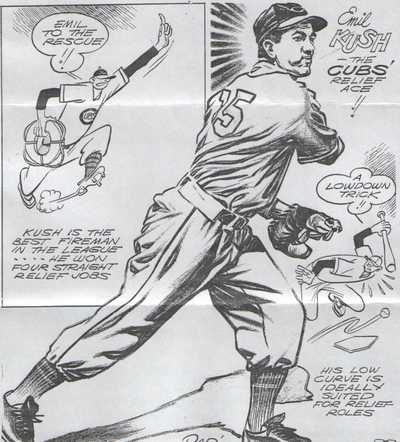

|
|
Emil Kush
Date and Place of Birth: November 4, 1916 Chicago, Illinois
Died:
November 26, 1969 River Grove, Illinois
Baseball Experience: Major League
Position: Pitcher
Rank: Unknown
Military Unit: US Navy
Area Served: United States
Emil Kush, a boy from Chicago’s northside, who waited nine years to make a boyhood dream come true, was rivaling the Boston Red Sox’ Earl Johnson as the number one relief pitcher in the major leagues today.
Associated Press June 5, 1946
In 1936, at the age of 19, he
attended a public tryout at Wrigley Field, and Cubs’ manager,
Charlie Grimm, was reasonably impressed with the young right-hander.
Emil was told to “leave his glove and spikes at the ballpark,” and
for the rest of the season he was paid $5 a day to pitch batting
practice.
Late in the season he was sent
to the farm team at Toledo, but when he did not appear in a game
during the Mud Hens’ road trip to the Twin Cities and Milwaukee, he
left the team in frustration.
Emil
pitched for Ponca City of the Western Association in 1937, compiling
a 14-14 record in 36 games. Meanwhile, his younger brother,
Ray Kush, earned a job catching batting practice with the Cubs.
In 1938, Emil was 17-14 in 41 games for Ponca City.
Emil hurled for Los Angeles of
the Pacific Coast League in 1939, appearing in 18 games with an 0-1
record. Although Emil lacked control he
had a natural sidearm sinker, a
pretty good curve and was voted the “fastest pitcher in the PCL”
that season.
In 1940,
Emil pitched eight games for Los Angeles and spent the remainder of
the season with Tulsa in the Texas League, where he had an 11-15
record. During that year he had two future major leaguers, Virgil
Trucks and Loy Hanning, pitch no-hitters against him.
Emil again started the year with
Los Angeles in 1941, and then returned to Tulsa where he posted a
14-13 record in 33 games. It was good enough for him to be called up
to the Cubs in September and he made his major league debut against
the Cardinals at Sportsman’s Park in St Louis on September 21, 1941.
He pitched two innings, giving up two hits and one run in the 7-0
loss. The starter in that game was Vern Olsen who was to become one
of Emil’s closest friends.
In March 1942, Emil was classified
3-A in the military draft because of a “family dependency” and
opened the season with the Cubs. He appeared in one game in late
April before being sent to Milwaukee of the American Association,
where he compiled a 9-12 record in 45 games.
During
the 1942 season, Emil and catcher, Bob Scheffing, went to Lambert
Field in St Louis, where they enlisted in the US Navy. Cubs’
catcher, Clyde McCullough, was already serving at Lambert Field and
he helped get the new recruits on to the baseball team. Emil was
assigned to the gymnasium as an instructor and pitched for the
Lambert Field Navy Wings in 1943, 1944 and 1945. On April 30, 1943,
Emil defeated the Cincinnati Reds, 3-2, in an exhibition game. Then,
on August 2, he beat Kirby Higbe and the Brooklyn Dodgers, 6-2, in a
game that had to be called in the seventh inning when Navy Wings’
first baseman Al Fisher was struck in the head by a Higbe fastball.
Emil was
discharged from the Navy on February 6, 1946. He joined the Cubs for
spring training at Catalina Island and then posted an excellent 9-2
record with a 3.05 ERA. “Not since Jack Russell, whose yeoman relief
work helped the Chicago Cubs win the 1938 National League pennant,”
wrote the Associated Press on June 5, 1946, “have the Bruins boasted
such a brilliant rescue artist as this 29-year-old righthander.”
In 1947, Emil was 8-3 and continued
to be one of the most effective relief pitchers in the majors before
arm trouble and an operation began to hamper his career.
He was 1-4
with a 4.38 ERA in 1948, and in 1949, his last season in the major
leagues, he finished 3-3 with a 3.78 ERA. The next two seasons he
pitched in the minors with Los Angeles and Milwaukee, before hanging
up his spikes in 1951.
Considered something of a jinxed
pitcher, Emil often spoke of a 1948 incident. With the Cubs leading
by two runs in the ninth with two out and two on, his centerfielder
knocked himself cold crashing into the wall pursuing a fly ball.
Before another outfielder recovered the ball, the batter circled the
bases for a game-winning homer.
On November 26, 1969, Emil
Kush, 53, was found dead from carbon monoxide poisoning in the
garage behind his home. He is buried in St. Joseph Cemetery in River
Grove, Illinois.
Thanks to Raymond D
Kush for information and the illustration contained in this
biography.
Created January 8, 2007.
Copyright © 2007 Gary Bedingfield (Baseball
in Wartime). All Rights Reserved. 